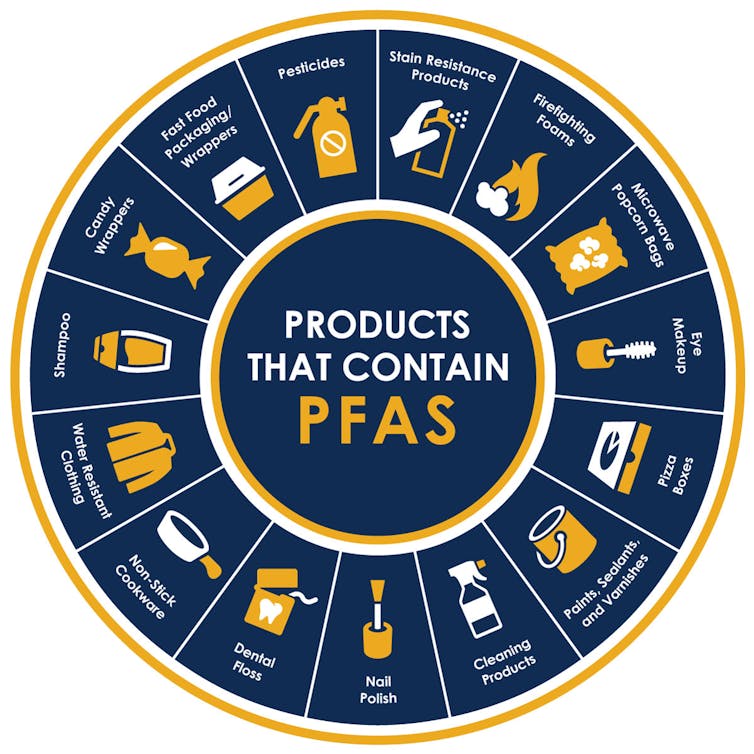Even if children’s stain- or water-resistant clothes are advertised as “green” or “nontoxic,” they might still contain PFAS, a group of manufactured “forever chemicals” that have been linked to a wide range of health problems in children.
In a new study, colleagues and I tested more than 90 water- and stain-resistant children’s items that are easily available in stores and online.
The results were eye-opening. We found PFAS in school uniforms, pillows, upholstered furniture and several other items. None of those products’ labels warned that toxic manufactured chemicals were present. In fact, many of them were advertised as nontoxic or green.
What’s wrong with PFAS?
PFAS (per- and polyfluoroalkyl substances) are a group of over 9,000 chemicals that contain a carbon-fluorine bond and are used for their persistent characteristics, such as their ability to withstand water, heat and grease.
These chemical are all around us – they are used in nonstick cookware, greaseproof food packaging, water-resistant clothing, touch screens and plastic molding, as well as firefighting foams and industrial processes. They get into water, soil, dust and the air people breathe, and they can bioaccumulate in animals.
They have also been found in the blood of over 98% of Americans tested and in the farthest reaches of the Earth. The relatively few PFAS that have been studied for their impact on humans have been shown to have associations with a wide range of health problems, such as cancers, increased cholesterol, interference with natural hormones and reduced vaccine response in children.

Children’s exposure to PFAS is of particular concern because children’s smaller size, developing bodies and changing hormones and physiology may make them more susceptible to effects from PFAS. A review of children’s exposure to PFAS and the health effects found evidence of associations between PFAS levels in the blood and changes in the age when children first begin menstruating; other findings included changes in kidney function and immune responses, along with dyslipidemia, an imbalance of fats in the blood, which can put children at risk for cardiovascular disease.
What we found in children’s products
Previous studies have found PFAS present in children’s clothing, some of which are advertised as “functional” fabrics with features such as water resistance. We sought to test whether the information on children’s product labels, specifically products advertised as stain- or water-resistant, would predict the presence of PFAS.
We also wanted to know if products advertised or certified as “green” or “nontoxic” indicated the absence of PFAS.
We looked at 93 products used by children or adolescents that fell into three broad product types: apparel, bedding and furnishings. Initial tests showed that 54 of those products had measurable levels of total fluorine, indicating the presence of PFAS. Our study partners at Alpha Analytical then tested those products for 36 individual PFAS.

We found that products advertised as water- and stain-resistant were more likely than other products to have detectable levels of total fluorine and higher levels of PFAS, though not all of them included PFAS. None of the other products had detectable levels of the PFAS chemicals that we tested for, though some had measurable levels of total fluorine.
Water- or stain-resistant products advertised as “green” or “nontoxic” had similar detections of PFAS and total fluorine levels to water- or stain-resistant products without any green assurances.
The product categories that had the highest measurements of PFAS were clothing, including school uniforms; pillow and mattress protectors; and upholstery from children’s furniture.
While our study didn’t measure exposure, there is potential for children in contact with these products to be exposed to PFAS compounds, including many we did not measure, such as volatile PFAS that can be inhaled. Studies have shown that with wear and washing, PFAS can leach out of durable or functional textiles, leading to increased potential for exposure and environmental contamination.
What can be done about it?
While more research is needed to quantify PFAS exposures from clothing and other children’s products, it’s worth asking why these chemicals are added to these products in the first place. The truth is that children are messy, and buying white clothing or using light carpeting in heavily trafficked rooms is just not practical.
The Environmental Protection Agency has been considering federal rules to limit PFAS use and possibly declare them hazardous substances. It’s a complicated debate with implications for the companies that make these chemicals and the products that contain them, and even for landfills and wastewater treatment plants.
Several states aren’t waiting. California recently passed a law that will phase out PFAS in children’s products. California, Maine, Vermont and Washington have banned PFAS in carpets and rugs. Maine has gone further to phase out non-essential use of PFAS in consumer products sold in the state by 2030. Several other states are considering limits or bans on some or all PFAS in different uses, including firefighting foams, drinking water, food packaging and ski wax.
As someone who buys used clothing, which doesn’t come with tags, for my children, I am concerned about exposure to PFAS. As our study showed, it’s hard to know when an item contains PFAS.
Certifiers of “green” products could help by ensuring that they include PFAS in their criteria. The precautionary principle would suggest avoiding noncritical uses of PFAS in general.
This article was updated to correct the description of Maine’s PFAS rules.
[Get science, health and technology stories from The Conversation in your inbox each Wednesday.]

